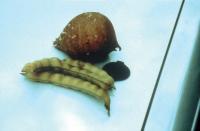
This small bean has great potential to provide high quality food production and offer a sustainable cropping system that has been needed in Africa. The Yam bean originated where the Andes meet the Amazon and is locally grown in South and Central America, South Asia, East Asia and the Pacific. It is produced in three species which are called the Amazonian, Mexican and Andean. Interbreeding of the bean has resulted in fertile and stable hybrids. This gives it potential to be reclassified as a single species, provide high quality food production and offer a sustainable cropping system that has been needed in Africa.
Researchers believe they have discovered a protein-rich starch staple in the yam bean in Peru. They were previously considered a root vegetable due to the high water content; however this ‘Chuin’ type has lower water content. Families living in the area have been producing it as flour. The crop has extremely high seed production, but its seeds contain high concentrations of rotenone. This toxic compound has been used for reducing fish populations and parasitic mites on poultry. Seeds are never consumed since they are mildly toxic to humans and other mammals. If the rotenone was removed from the seeds, they could provide a strong protein source as well as seed oil profitable in the food industry.
Séraphin Zanklan, a scientist at Centre Songhai in Porto-Novo (Benin), has investigated the yam bean for its potential to grow and produce food under West African conditions. The study was funded by a scholarship from the German Academic Exchange Service (DAAD). Thirty-four yam genotypes were grown with and without flower removal at one droughty location and one irrigated location. Of the 33 traits that were measured, nearly all showed large genetic variation. This and the easy spreading of its seeds, make the crops very desirable to breeders. Results from the study will be published in the July-August 2007 issue of Crop Science.
The study identified genotypes with high storage root production. Flower removal increased storage root production by 50 to 100%. Several yam bean genotypes showed very low reduction in storage root and seed production under drought stressed conditions. As expected, the storage roots did show high protein and starch contents. They have as much as three to five times more protein than potatoes or yams. Most importantly, it was found that storage roots can be processed into ‘yam bean gari.’ This is similar to the current staple of West Africa, ‘cassava gari,’ a granular flour.
The bean could make a significant contribution to the improvement of food support, especially where resources are poor. The research is ongoing at the International Potato Center, which has a mandate for the bean in the frame of Andean Root and Tuber Crops. Further evaluation is needed on the range of yam bean variations under different conditions. More information on where they can be grown, their agronomic potential and genetic diversity is important to determine the types of breeding programs necessary for yam beans. Source : American Society of Agronomy
 Print Article
Print Article Mail to a Friend
Mail to a Friend
